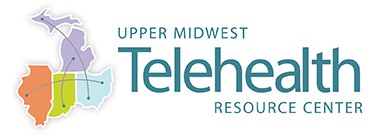[ad_1]

Telehealth is expected to more than double in size over the next few years to at least $43 billion
SOUTH BEND, Ind. (PRWEB)
July 07, 2021
Dramatic telehealth growth is transforming the healthcare industry, bringing with it major changes for patients, families, physicians and medical professionals in every sector.
At the beginning of the 2020 pandemic, many clinics and hospitals were conducting a handful of telehealth visits a day between patients and medical professionals. By mid-April of 2020, daily non-urgent telehealth visits had grown a staggering 4,000 percent, according to the Journal of American Informatics Association.
“During the pandemic year, telehealth services went from an emerging alternative to a dominant solution for the delivery of certain types of healthcare, including urgent situations,” said [Becky Sanders, Program Director for the Upper Midwest Telehealth Resource Center (UMTRC). “Telehealth as a market went from a few million dollars annually a decade ago to an astonishing $10 billion in 2020 and is expected to more than double in size over the next few years to at least $43 billion.”
Supported in part by federal regulatory changes that allowed integration of and compensation for healthcare services delivered online, telehealth grew dramatically during the lockdown period of the pandemic, allowing physicians and medical professionals to securely conduct patient visits.
“In-home and remote telehealth visits have now become a preferred means of healthcare delivery for many patients, particularly in rural areas, and numerous experts expect a continued tsunami of telehealth growth,” noted Sanders. “All indicators are that the present rate of rapid growth and popularity of telehealth among patients and providers will only continue.”
To help medical professionals, institutions, government and regulatory leaders better understand and grasp profound changes in the telehealth marketplace, UMTRC organized its annual conference here to focus on “The New Normal” in telehealth delivery.
A full lineup of telehealth experts from all over the Midwest will gather in South Bend July 20 and 21 to review, discuss and plan for major continued changes in telehealth, both from professional practice and consumer perspectives. The South Bend location serves as a central point for people traveling from Illinois, Michigan and Ohio to attend.
“For those engaged in patient engagement and healthcare service delivery, this is a ‘can’t miss’ conference,” said [ Cara Veale, CEO of the Indiana Rural Health Association (IRHA). “This industry is changing day-by-day, and the conference presenters are industry experts who will provide a critical strategic view.”
Rural telehealth expansion holds its own set of challenges and benefits, which will be a special focus of the conference.
A much-anticipated keynote on the history and future of telemedicine and telehealth will be presented July 20 by Charles R. Doarn, a research professor and expert from the University of Cincinnati College of Medicine. Doarn’s deep experience reflects his recognized expertise on strategic telehealth applications, ranging from addressing dynamic changes in healthcare delivery to disaster management to telemedicine needs on the International Space Station.
Titled “The Ever-Expanding Telehealth Universe,” a second major keynote address will be delivered on Wednesday morning by attorney Katea Ravega, a partner and healthcare lawyer with the law firm Quarles & Brady, LLP in Indianapolis. Ravega will bring her seasoned perspective on telemedicine regulations, compliance issues and transactions for hospitals, clinics, practices and companies contemplating telehealth market expansion.
Several other experts, medical professionals, hospital administrators and university professors will present during the conference. Topics includes “How to Prepare Patients for the Telehealth Experience,” “Provider Burnout and the Electronic Health Record,” Virtual Engagement during a Public Health Emergency,” “Overcome Barriers and Accelerate Organizational Telehealth Success,” “Comprehensive Device-Enabled Exams,” “Broadband and Community Health Needs Assessments,” and more.
“The conference is designed to be of interest to a wide range of professionals engaged in rural telehealth including community leaders, clinicians, administrators, board members, public health officials, rural health clinics, federally qualified health centers, local health departments and others interested in the development of Telehealth care in their community,” noted Sanders. “The events are created for anyone with an interest in rural health care, including rural health practitioners, hospital administrators, clinic directors and lay health workers, social workers, state and federal health employees, academics, community members and more.”
The two-day event will take place at the Gillespie Conference and Special Event Center in South Bend, Indiana. Registration for the conference ends on Friday, July 9. For more information, please visit https://www.umtrc.org/annual-conference/2021/umtrc-annual-conference/
# # #
ABOUT UMTRC – A National Rural Health Association (NRHA) Fellow, Becky Sanders serves as program director for the Upper Midwest Telehealth Resource Center, which helps advance telehealth operations in Indiana, Illinois, Michigan, and Ohio. UMTRC is a federally funded program of the Indiana Rural Health Association (IRHA) that provides a comprehensive set of telehealth clinical and technical assistance services leveraged into products of lasting value to rural providers. For more information, please visit https://www.umtrc.org/
About the Indiana Rural Health Association – The Indiana Rural Health Association was organized in 1997 and is a nonprofit organization working to enhance the health and well-being of rural populations in Indiana through leadership, education, advocacy, collaboration, and resource development. The strength of the organization is through the present diverse membership and the founding organizers who are committed to impacting the health of citizens through the identification of rural health issues and through advocacy roles in both the public and private sectors. IRHA membership is made up of 3,300 diverse individuals and organizations, making it the largest state rural health association in the nation, and a nationally recognized leader in rural health care. For more information, visit http://www.indianaruralhealth.org
[ad_2]

